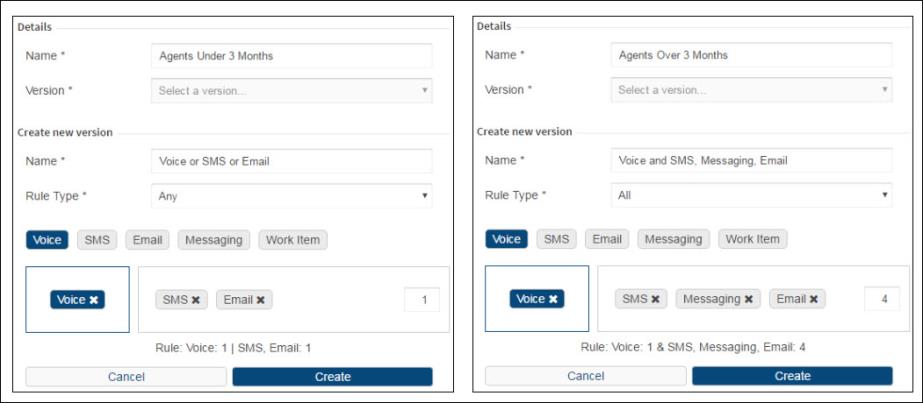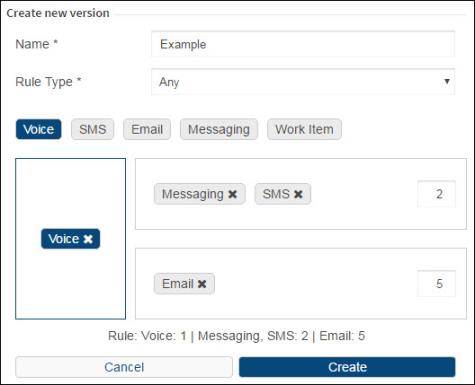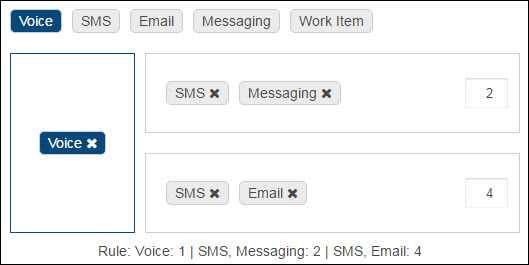Capacity Rules
Capacity rules define the type and volume of work that an agent can receive before they are considered fully allocated. Once an agent becomes fully allocated, they will not receive any more work items until their allocation status changes to either partially allocated or not allocated. A capacity rule can have multiple conditions included so that agents can continue to receive work offers until they are at full capacity from any combination of those conditions.

|
The Voice channel is an exception and assumes that an agent is busy when taking a single call. CxEngage will not send additional calls to an agent until their current call is complete. CxEngage may continue to send non-voice work offers, depending on the capacity rule configuration. |
Capacity rules are created with one of the following types:
- Any: An agent is considered to be fully allocated and will not be offered additional work items if any of the individual capacity rule components are met.
- All: An agent is only considered to be fully allocated and will not be offered additional work items when all of the individual capacity rule components are met.
- Percentage: Each channel type is assigned a percentage value that defines the percentage of the agent's total capacity that each type of interaction will occupy. The lower the percentage, the more interactions of each type can be handled concurrently. The higher the percentage, the more that each interaction of that type requires of that agent's capacity and the fewer concurrent interactions can be assigned before reaching the 100% limit.
NOTE: The Percentage rule type is currently available on the Early Access (EA) version of Capacity Rules Management in the configuration UI. This page is enabled by default on all tenants but can be disabled from the Early Access page.
Capacity rule conditions are configured for each of the work offer types that your agents may handle. You can combine different channels for a condition, or have separate conditions configured for each one.

|
The Messaging channel includes any of the chat messaging options, including web chat and Facebook Messenger.
|
Capacity rules are assigned at the user level within the configuration console. When a rule is assigned, incoming work offers can continue to be sent to the agent while they have capacity for that type of work as defined in the rule conditions.

|
Agents who do not have a capacity rule assigned to them are eligible to receive one work offer at a time from any of the channels that are used by your tenant and are routed to that agent based on the flow, queue, and skill settings that you have configured. |
Similar to other CxEngage features such as flow, you can save multiple versions of a capacity rule. You can change the active version to support your capacity needs.
Example Scenario 1 (Any & All)
You may choose to have fewer work items assigned to newer agents than to your more experienced ones. You can do this by configuring different capacity rules that allow for different volumes of work and assign them to individual users as needed.
To manage this scenario, you may have two different capacity rules for the different agent experience or skill levels.

What do these rules mean?
- An agent assigned to the first capacity rule can only receive one voice call, or one email, or one SMS interaction at a time. Agents with the first rule are not eligible for any message work offers.
- An agent assigned to the second capacity rule can receive one voice call, and also up to four of any combination of email, SMS, and message work offers.
Example Scenario 2 (Any)
You may only want your agents receive a small number of SMS or messages at a time, but have those agents available to accept a larger number of emails at one time.

What does this rule mean?
- This is an "Any" rule type, meaning that once any of the condition statements are met, that agent is considered fully allocated. Two SMS or message interactions would fully allocate the agent. One message or SMS would partially allocate them. That means that they are still available for additional non voice work items.
- Five emails would fully allocate an agent. Four emails would partially allocate them. That agent could then receive either an additional email or a message/SMS. That fifth work item type will determine if the agent then becomes fully allocated or remains partially allocated:
- If the fifth work item is another email, the agent would be fully allocated and unavailable for additional work until an interaction is ended.
- If the fifth work item is an SMS or message, the agent hasn't filled either condition yet and can continue to receive one more work offer from either grouping.
Example Scenario 3 (Percentage)
You may want a dynamic configuration that allows for a variety of combinations based on channel type percentages and not solely on defined limits per channel.

What does this rule mean?
- This is a "Percentage" rule type, meaning that any combination of interactions may be handled concurrently so long as the agent's capacity does not exceed 100%.
- A single voice call continues to fully allocate an agent, as with other rule types.
- An email interaction takes 25% of an agent's capacity, meaning they can handle up to 4 of them concurrently without exceeding their capacity. SMS is 50% of capacity, meaning they can handle up to two concurrent SMS interactions.
- A Messaging item is 75%. There's no way to handle more than one Message concurrently without exceeding their capacity. They could, however, handle one message (75%) and one email (25%). A message (75%) and SMS (50%) would not be allowed, because those that would exceed 100%.
- This agent can be assigned any combination that results in 100% capacity or less. For example, four email interactions (25% + 25% + 25% + 25% = 100%), or two emails and one messaging (25% + 25% + 50% = 100%).
Capacity rule conditions work in conjunction to determine if an agent is partially or fully allocated. When you create a capacity rule with more than one condition, ensure that those conditions are compatible and don't conflict with each other. For example, if one condition says that an agent can receive two SMS messages there shouldn't be another condition that includes the SMS channel and a volume count higher than two.
Here is an example of conflicting capacity rule conditions.

The first condition states that an agent can receive up to two work offers between the SMS and messaging channels. However, the second condition states that the same agent can receive up to four work offers between SMS and email. The conditions conflict with each other because SMS is included in both channels with different maximum values.

